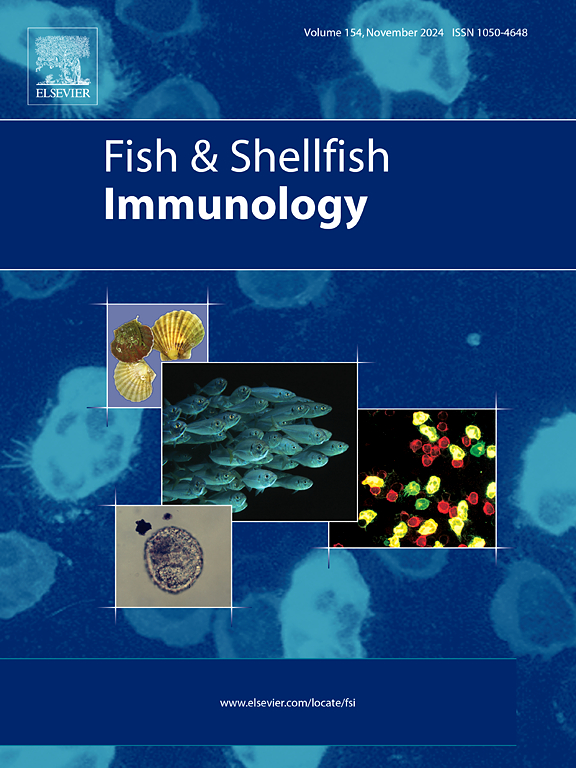文昌鱼核糖体蛋白L27抗菌肽的鉴定
IF 4.1
2区 农林科学
Q1 FISHERIES
引用次数: 0
摘要
抗菌肽(AMPs)来源于多种蛋白质,如核糖体蛋白,在先天免疫系统中起着关键作用。然而,关于核糖体蛋白衍生的amp的信息目前有限,其作用机制仍然不明确。本研究鉴定了文文鱼RPL27 (BjRPL27)的抗菌活性及其位于51-72残基的核心功能区(称为BjRPL2751-72)。我们发现细菌感染后,BjRPL27在肝盲肠中的表达上调。重组蛋白rBjRPL27和合成肽BjRPL2751-72均通过破坏细胞膜完整性、诱导膜去极化、增加细胞内活性氧(ROS)产生等共同作用,有效杀伤革兰氏阳性菌金黄色葡萄球菌和革兰氏阴性菌嗜水气单胞菌。此外,BjRPL2751-72的序列在所有真核RPL27中高度保守,这意味着RPL27家族的抗菌活性具有古老的起源。体内实验表明,BjRPL2751-72不仅能有效保护斑马鱼免受嗜水单胞菌感染,还能杀死大鼠皮肤创面上的金黄色葡萄球菌。此外,BjRPL27和BjRPL2751-72都没有表现出对人红细胞的溶血活性,这使它们成为设计新型amp的有希望的先导分子。这些发现突出了BjRPL2751-72作为一种具有选择性杀菌特性的新型AMP的潜力。本文章由计算机程序翻译,如有差异,请以英文原文为准。
Identification of a novel antimicrobial peptide from amphioxus ribosomal protein L27
Antimicrobial peptides (AMPs), derived from a variety of proteins such as ribosomal proteins, play a pivotal role in the innate immune system. However, information regarding ribosomal protein-derived AMPs is currently limited and their mechanisms of action remain poorly defined. Here we identified and characterized the antibacterial activity of amphioxus RPL27 (BjRPL27) and its core functional region located at residues 51–72 (termed BjRPL2751-72). We found that BjRPL27 expression was upregulated in the hepatic caecum following bacterial infection. Both the recombinant protein rBjRPL27 and the synthetic peptide BjRPL2751-72 effectively killed the Gram-positive bacterium Staphylococcus aureus and the Gram-negative bacterium Aeromonas hydrophila via a combined action of disrupting cell membrane integrity, inducing membrane depolarization, and increasing intracellular reactive oxygen species (ROS) production. Additionally, the sequence of BjRPL2751-72 was highly conserved among all eukaryotic RPL27s, implying an ancient origin for the antibacterial activity of the RPL27 family. In vivo assays showed that BjRPL2751-72 not only efficiently protected zebrafish from A. hydrophila infection, but also killed the bacterium S. aureus on the skin wound of rats. Furthermore, neither BjRPL27 nor BjRPL2751-72 exhibited hemolytic activity towards human red blood cells, making them promising lead molecules for designing novel AMPs. These findings highlight the potential of BjRPL2751-72 as a novel AMP with selective bactericidal properties.
求助全文
通过发布文献求助,成功后即可免费获取论文全文。
去求助
来源期刊

Fish & shellfish immunology
农林科学-海洋与淡水生物学
CiteScore
7.50
自引率
19.10%
发文量
750
审稿时长
68 days
期刊介绍:
Fish and Shellfish Immunology rapidly publishes high-quality, peer-refereed contributions in the expanding fields of fish and shellfish immunology. It presents studies on the basic mechanisms of both the specific and non-specific defense systems, the cells, tissues, and humoral factors involved, their dependence on environmental and intrinsic factors, response to pathogens, response to vaccination, and applied studies on the development of specific vaccines for use in the aquaculture industry.
 求助内容:
求助内容: 应助结果提醒方式:
应助结果提醒方式:


